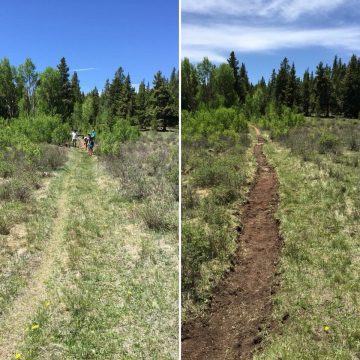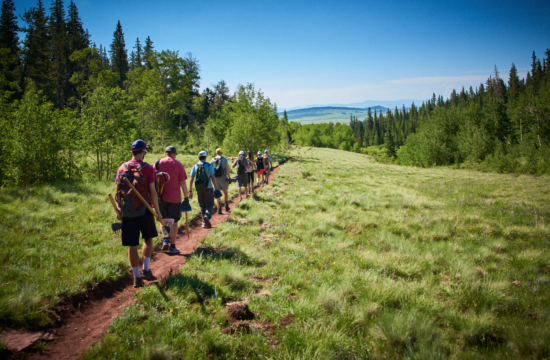By HPRS RD John Lacroix
Having grown up in New Hampshire, participating in Boy Scouts, and utilizing many of the trails maintained by The Appalachian Mountain Club (AMC), it has long been instilled in me that “we must leave it better than we found it.”
2005 isn’t just the year when I became an ultramarathon runner, it was the year I was trained as a Lead Volunteer Trail Adopter with The AMC. The first trail I cared for was the Jefferson Link Trail located high above tree line in New Hampshire’s Northern Presidential Range, home of the world’s worst weather. The primary tasks on this trail included moving many the many stones in massive boulder fields, in order to make it obvious where the trail goes via scree walls; I built and cleaned many rock water bars; and I built and maintained countless piles of rock pathfinders known as cairns.
The job of taking care of this trail in the White’s was hard, arduous, tedious work. The granite stones, and glacial erratic’s, that make up the NH landscape chews your hands to absolute garbage, like you’ve dragged your fingers across a rasp file for hours and hours on end. As trail adopters the AMC asked us to put in three trail work days a year: one each in spring, summer, and fall. The trouble was in finding days suitable enough to complete the work without risking one’s own life through constantly changing, severe, and wet weather conditions. We made do.
After 2 seasons above tree line, I made the request to move to a new trail. My first request was the Carter-Moriah Trail on the next ridge-line over from the Presi’s. My work on Mount Jefferson had chewed, scraped, cut, and bruised my hands to the point that they could have used the break. Carter-Moriah trail needed far more work seeing as it was in the trees. Most of the work required hand pruners and loppers to cut back the evergreen and krummholz trees that acted more like a human carwash. We also had to clear water bars in the shoulder seasons, dig and place stone steps, and repair bridges that had been washed away by flooding rains and excessive snow melt. It was glorious rewarding work, and I even ended up naming my first son after the time my significant other and I had spent caring for this trail; Carter.
At one point in my 20s I was a peakbagger. After finishing the list of New Hampshire’s 48 four-thousand-foot peaks, I took on a list known as The Trailwrights 72. Instead of a 300’ col rule like the 48 requires, Trailwrights only required 100’ of rise from the low point between peaks, and many of these peaks were trail-less bushwhacks. Trailwrights also mandated that you could only count one peak per trip, even if you hiked a ridge that included 4 or 5. So only 1 peak counted for each ascent and descent, meaning you had to take 72 individual trips. The other requirement for completing the Trailwrights list, was having to conduct 72 hours of volunteer trail work; half with trailwrights, and half with someone else like the AMC. At age 28, I became the youngest person ever to complete the Trailwrights 72, and all trail work required for recognition.

In 2013 I wrote an op ed about the necessity for race series’, especially ones the size of Leadville, to give back to the trails they use for their events by hosting at least one trail work day a year. After all, using trails for our athletic endeavors, and our business endeavors as race directors, is a privilege and not a right. Trails don’t just magically appear, and they certainly don’t care for themselves. By putting literally thousands of runners on any given trail, every single year for over three decades, one would think that giving back would be a top priority for a series like Leadville.
But it wasn’t. It honestly shocked me when a handful of runners in our community attacked me personally instead of talking about the topic of conversation, our duty to conduct trail work. Instead of talking about why they didn’t think it was important to do trail work, or why trail work shouldn’t be required of races; they made comments like, “Has this guy ever done any trail work himself? Does he even know how much time and effort that involves? I bet this guy never lifted a shovel in his life.” Etc etc.. you get the idea.
This type of behavior seems rather commonplace now-a-days and wouldn’t be as surprising now as it was back in 2013. Social media keyboard warriors attacking the person instead of discussing the subject matter, not a novel concept. I felt that it also highlighted the sense of entitlement that is present with some communities of runners, where they felt the suggestion of doing trail work as a condition of entry, or even in general, was far too much to ask or an obvious overreach.
One of the other things that was flung my way by more than one individual was, “If you don’t like how they do it, start your own.” So in 2014 when I approached the United States Forest Service (USFS) to request permission for permitting our events in and around Fairplay starting the following year, I made it clear that a priority of HPRS was not only sustainability but giving back to the many trails we use and abuse to host our events within the district. Prior to even getting a “yes” for hosting our events, The Human Potential Running Series (HPRS) became the first race series in Colorado to become official trail adopters of USFS trails. We were able to identify just shy of 11-miles of USFS trail, some that we use and some that we don’t, as ours to take care of moving forward.
HPRS has hosted three trail work days a year in Fairplay Colorado ever since. These days are traditionally the day after the June South Park Trail Marathon & Half, the day after the August Sheep Mountain Ultras, and the day before the July Silverheels 100-Mile. As you can imagine, yes… we’re typically very tired from race preparations or getting through race weekend before we even lift a shovel. These trail work days are far too important just to skip. It is our duty, our ethical obligation, to give back to these trails and mitigate our impacts; it can’t always be take, take, take.
So no, I didn’t like how others were doing it and I knew we could and needed to do better. Our community needed to do better. The response to someone suggesting that we do more in giving back to our trails should never be a personal attack. Frankly, attacking others for suggesting we work harder, instead of getting behind a cause like this, speaks more about the character of those not doing the work.
Over the years I have written many articles and produced a handful of podcast episodes where I specifically speak on this subject. In many of those instances I speak candidly about the realities we face as a sport if we don’t all pitch in to do some work. Again, the reality is that should a trail be used to death, or suffer from deferred or a lack of maintenance, land managers will remove the trail from a part of its recognized network. When this occurs, the trail is closed to all usage, and specifically special event usage. In other words.. if we don’t take care of the trails we use, we’ll lose the opportunity to use them.
The Human Potential Running Series has done more than adopt 11 miles of USFS trail. These last few years we’ve reinvesting a few thousand dollars into our trail work efforts by purchasing our own cache of tools to use on trail work days, ensuring that we don’t have to borrow from other organizations. I have sat on many committees focused on trail issues and improvement efforts all around the Denver Metro-area. In addition to our trail work in Fairplay we have conducted 1-2 trail work days at year at Indian Creek, and have adopted sections of The Ozark Highlands Trail in Arkansas in addition to donating hundreds of dollars to the OHTA. There is no denying that HPRS has taken the call to give back more seriously than most, and we are grateful that our community has joined us. “If you don’t like it.. you do it.”
OK…

When I first adopted those trails in Fairplay, I said to myself, “Even if I’m the only one doing the work, we have to work these routes.” Early on in our trail work initiatives, it would be commonplace for us to have 3-5 trail work volunteers at most, and more often than not we were more towards that number 3. It was not only incredibly sad, but beyond frustrating. A few years ago I decided that anyone who did a trail work day with HPRS would receive a complimentary race entry in exchange for their labor. Even with this dangling carrot working to sweeten the pot, growth in trail work numbers came slowly.
Over the last two seasons we’ve sold out more trail work days than not, often times opening a waiting list for those still looking to help. I continue to applaud those races in our community who require trail work as a condition of entry like the High Lonesome 100, Ouray 100, Hardrock 100, Western States 100, and Cascade Crest 100 to name a few. One day of trail work is not the most difficult day of work us ultrarunners will ultimately do, and I do wish that the precedent of requiring trail work for entry into 100-milers was more commonplace than it is. I believe that every ultra running event in the country should be required to conduct a day of trail work as a condition of obtaining their permit(s). Use of trails for events like ours is indeed a privilege and not a right.
Since 2015 The Human Potential Running Series has held a total of 22 trail work days that have accounted for 1,528 total man hours of volunteer trail work. There isn’t a race or series in Colorado who even comes close to our numbers within that same time period. As a community, we can and must do better, or the privilege to use trails for events like ours will quickly disappear.

